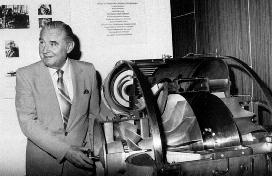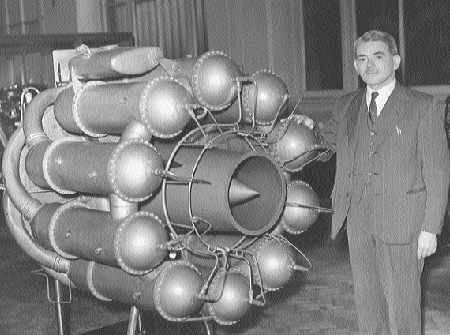 The National Advisory Committee for Aeronautics (NACA) entered the effort to achieve victory in World War II by pursuing aeronautical R&D across a broad front. Overall, the NACA was justifiably pleased with its contributions in terms both of applied and fundamental research during World War II. A January 1944 issue of Aviation described in proper patriotic fashion the agency’s efforts and urged support for it:
The National Advisory Committee for Aeronautics (NACA) entered the effort to achieve victory in World War II by pursuing aeronautical R&D across a broad front. Overall, the NACA was justifiably pleased with its contributions in terms both of applied and fundamental research during World War II. A January 1944 issue of Aviation described in proper patriotic fashion the agency’s efforts and urged support for it:
How much is it worth to this country to make sure we won’t find the Luftwaffe our superiors when we start that “Second Front”? We spend in one night over Berlin more than $20,000,000. The NACA requires—now—$17,546,700 for this year’s work. These raids are prime factors in winning the War. How can we do more towards Victory than by spending the price of one air raid in research which will keep our Air Forces in the position which the NACA has made possible?
NASA official John F. Victory remarked that “The employees of the NACA have a big and important job to do. They are at war with similar research organizations in Germany, Japan, and Italy. It is their responsibility and they are using their technical knowledge and skill to make sure that the airplanes that are given to American and allied flyers are better and more efficient instruments of war than those flown by enemy airmen.”
At the same time, the NACA failed to comprehend the promise of jet propulsion in the years predating the war. Perhaps no technological innovation has been more significant for the development of aviation of all types than the turbojet engine. A relatively simple engine in its principals, the jet required a unique combination of metallurgical capability, cooling and velocity control, and an unconventional understanding of Newton’s third law of motion.
The NACA, as well as many other aeronautical research institutions, had dallied with the concept in the 1920s and abandoned it because the combination of factors required to make it a viable option were not present. Whereas other individuals and agencies returned to the concept periodically thereafter and found success in its development at least by the mid-1930s, the NACA ignored the jet propulsion problem and was notoriously left behind in jet development. It had to make a crash effort in the 1940s, in some cases literally, and get help from the British, to catch up with developments elsewhere.
Virtually every historian who has dealt with the issue of jet propulsion in the United States has asked the same question: why did the leading aeronautical nation in the world misjudge the potential of jet propulsion so badly? Those interested in the history of the NACA posit several reasons for its blinders in dealing with this subject, and their explanations represent the best wisdom available on this problem. They suggest four interrelated factors. First, few Americans were interested in tackling the jet problem because of the overall approach to aviation in the nation. Most research into the problems of propulsion was conducted by or for the engine manufacturers and it was in their best economic interest to make incremental improvements to existing engines. Consequently, few were asking the question about jets in the 1920s and 1930s and the NACA saw little reason to proceed on its own. When it created a special committee under the leadership of Stanford University’s William F. Durand to study jet propulsion in 1941, aircraft industry representatives were explicitly omitted because they were economically wedded to the propeller.
Second, in contrast to European engineers like Frank Whittle and Hans von Ohain, no Americans perceived that the combination of compressor and turbine was uniquely suited as a power plant for flight. Whittle and von Ohain were drawn to the turbojet because its simplicity and unique characteristics made it a system ideally adapted to flight. Although the NACA had some of its engineers investigate jet power, they were exploring avenues, such as the Campini ducted-fan power plant, that really had very little practical application, and when their work hit a dead end the Committee terminated the research. No one in America, it seems, grasped the potential of the turbojet until Hap Arnold returned from Britain with plans for the Whittle engine and a collective light bulb went on over the head of the NACA and other American R&D organizations.
Third, the economics of aeronautical R&D weighed against NACA’s heavy involvement in the development of the jet engine. The small and poor organization had always been forced to pursue research questions upon which it was uniquely suited to make significant contributions. The NACA engineers made conscious decisions to work in directions that might be more immediately productive. Jet propulsion research was, for many of them, a luxury they could not afford to pursue even if they had thought it worthwhile. The Langley facility was swamped and created a “bottleneck” in R&D in the 1930s, and by the time the Sunnyvale and Cleveland laboratories opened, the wartime increase in work was in full swing.

Dr. Hans-Joachim Pabst von Ohain beside his He S 3A jet engine which he invented, developed and successfully tested in 1936.
Finally, and this is by far the most significant area of concern, there was a problem of leadership among those who were interested in aeronautical R&D that mitigated against the NACA’s timely and effective research into jet propulsion. The principal clients of the NACA were the military services, and they neither appreciated the potential of jet propulsion nor asked the Committee to work on the problem. In fact, to appreciate the full potential of the jet engine individuals had to possess sensitivity to the convergence of thermodynamic and aerodynamic principles. Few Army officers, even aviators, had the technical background to grasp this situation. This was, of course, part of a broader trend in the prewar Army; it did not understand the implications of the scientific revolution that was transforming warfare through such developments as radar, jet propulsion, atomic weapons, and other similar technological developments. They, until the war was underway in Europe and Britain shared the Whittle engine with the United States, did not press for work in jet propulsion.
The NACA leadership was little better. It did not exploit its self-proclaimed primacy in basic research toward the theoretical studies of jet propulsion that should have been fostered. It failed to pick up on European work in turbojets, even though some professional conferences addressed these issues in the 1930s. It always possessed, it seems, a bias against engine research regardless of the type of engine. Perhaps the fact that it had built its many wind tunnels—and had developed world-leading expertise in aerodynamic research because of them—prompted the NACA to give shorter shrift to engine research.
These factors, as well as others of a more subtle nature, came together to retard American efforts in this aspect of aeronautical R&D. The British developments shook both the NACA and other American aviation agencies out of their malaise, however, and during the war significant improvements resulted in aircraft that that could reach much higher speeds in the post-war era.



Interesting post. Your description of NACA as a laggard with respect to jet technology contrasts with Murray and Cox’s description (in Apollo: Race to the Moon) of NACA’s Langley center as a tech utopia for budding engineers: a hermetically sealed community that was putting out cutting edge papers in aeronautical engineering. Or perhaps they were advanced in areas other than jet tech? Nice seeing you at AHA, by the way.
LikeLike
Interesting article particularly that quote from 1944 which is same argument by NASA except it was NACA and billions were millions (also a much different enemy).
Instead of industry pursuing the jet engine, “… it was in their best economic interest to make incremental improvements to existing engines.” Some years ago someone wrote in a forum (not all but some of it here):
-quote- Corporate Overlords don’t like true Progress, of the disruptive sort. They like progress, (with the lower-case “p”) of the incremental sort, the kind that keeps their guaranteed spot on top, and keeps them making money the same way they made it last year, only more of it. Microsoft once mentioned “managing the pace of change in the industry,” which I would imply to mean managing the pace of change so they can retain their “leadership” role. Even so, every now and then a disruptive innovation like the Internet manages to sneak through. Real War, that is. War like WWII, not war like Viet Nam or Iraq. Real war threatens the very existence of Our Corporate Overlords, because if we lose, they’re toast. So when real War happens, the brakes on disruptive innovation are removed, because survival is at stake. As long as you win, you have a chance of retaining your spot on top, and will most likely be alive. If you lose, both are in doubt. -end quote-
However, I’m surprised the jet engine did not get the attention it did during WWII or NACA was busy with high subsonic flight i.e. high speed buffeting of P51s (or maybe it did but had to compete with other innovations like atomic power).
Regarding disruptive innovation, it seems if not for WWII, things like nylon, penecillin, and FM radio would high proprietary and expensive items.
LikeLike